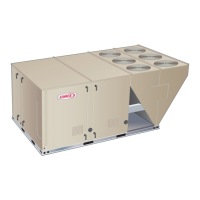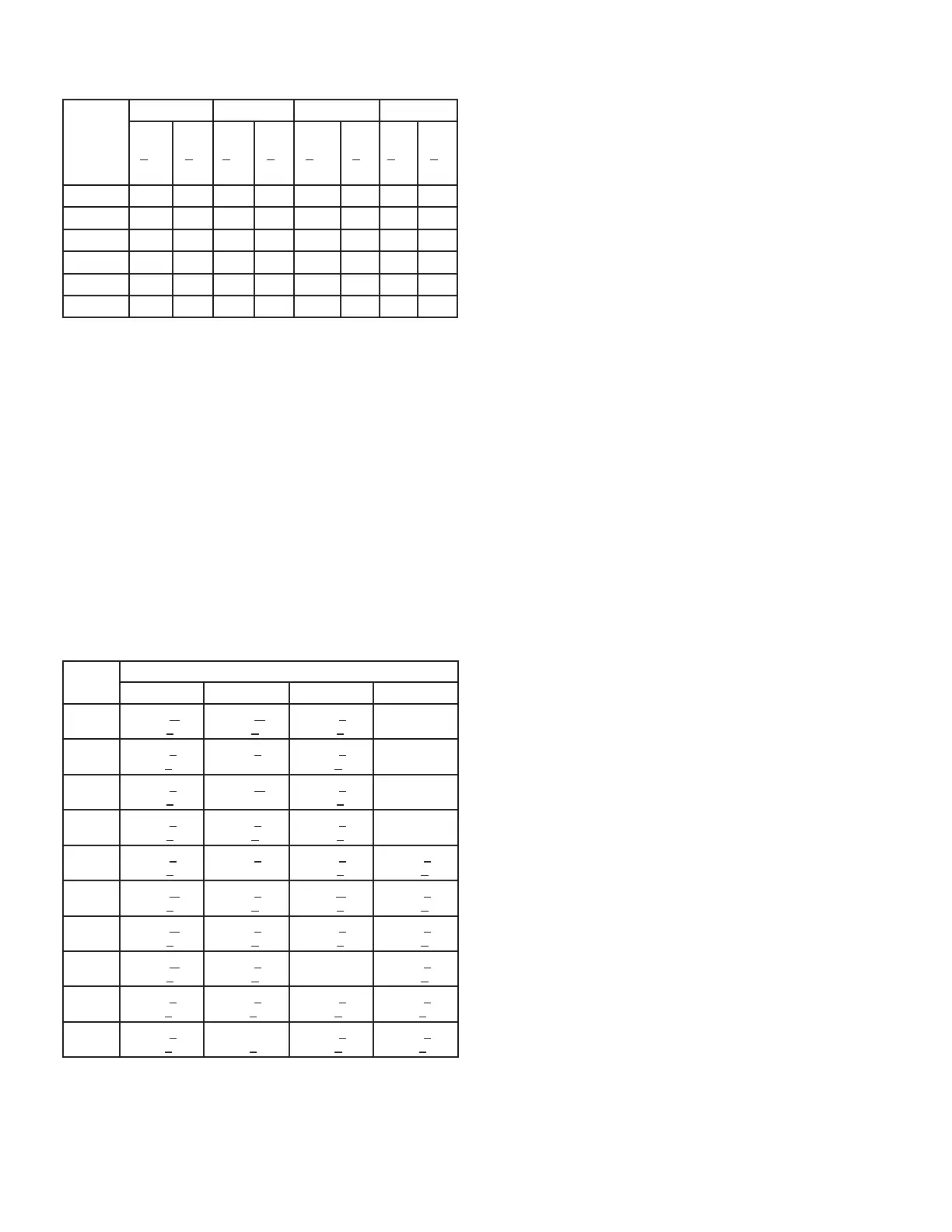Page 35
TABLE 18
300 Reheat Compressor 1 Frequency 68Hz - 581023-01
Outdoor
Coil
Entering
Air
Temp
Circuit 1 Circuit 2 Circuit 3 Circuit 4
Dis.
+10
psig
Suc.
+5
psig
Dis.
+10
psig
Suc.
+5
psig
Dis.
+10
psig
Suc.
+5
psig
Dis.
+10
psig
Suc.
+5
psig
274 121 120 114 275 120
124 122 301 123 317 128
387 124 131 135
415 442 127 137 414 141
132 130 447 142 144
525 558 133 502 145 147
-
1 - Using the same thermometer, compare liquid
temperature to outdoor ambient temperature.
Approach Temperature = Liquid temperature (at con-
denser outlet) minus ambient temperature.
2 - Approach temperature should match values in table
shown indicates an undercharge. An approach
temperature less than value shown indicates an
overcharge.
3 - The approach method is not valid for grossly over or
a guide for typical operating pressures.
TABLE 19
APPROACH TEMPERATURES - FIN/TUBE COIL
Unit
Liquid Temp. Minus Ambient Temp.
1st Stage 2nd Stage 3rd Stage 4th Stage
Std.
+ 1
+0.5)
+ 1
+0.5)
+ 1
+0.5)
NA
Reheat
+1
+0.5)
+1
+1
+0.5)
NA
180
Std.
+ 1
+0.5)
+ 1
+ 1
+0.5)
NA
180
Reheat
+ 1
+0.5)
+ 1
+0.5)
+ 1
+0.5)
NA
210
Std.
+ 1
+0.5)
+ 1
+ 1
+0.5)
+ 1
+0.5)
210
Reheat
+ 1
+0.5)
+ 1
+0.5)
+ 1
+0.5)
+ 1
+0.5)
240
Std.
+ 1
+0.5)
+ 1
+0.5)
+ 1
+0.5)
+ 1
+0.5)
240
Reheat
+ 1
+0.5)
+ 1
+0.5)
+ 1
+0.5)
300
Std.
+1
+0.5)
+1
+0.5)
+1
+0.5)
+1
+0.5)
300
Reheat
+1
+0.5)
+0.5)
+1
+0.5)
+1
+0.5)
IV-STARTUP - OPERATION
Refer to startup directions and to the unit wiring diagram
when servicing. See unit nameplate for minimum circuit
ampacity and maximum fuse size.
A-Preliminary and Seasonal Checks
1 - Make sure the unit is installed in accordance with
the installation instructions and applicable codes.
2 -
installed for loose connections. Tighten as required.
Refer to unit diagram located on inside of unit
control box cover.
3 - Check to ensure that refrigerant lines are in good
condition and do not rub against the cabinet or
other refrigerant lines.
4 - Check voltage. Voltage must be within the range
listed on the nameplate. If not, consult power
company and have the voltage corrected before
starting the unit.
5 - Recheck voltage and amp draw with unit running. If
voltage is not within range listed on unit nameplate,
stop unit and consult power company. Refer to unit
nameplate for maximum rated load amps.
Inspect and adjust blower belt (see section on
Blower Compartment - Blower Belt Adjustment).
circuits
NOTE-Crankcase heaters must be energized 24 hours
before attempting to start compressor. Set thermostat so
that there is no demand to prevent compressor from cy-
cling.
Apply power to unit.
1 -
according to instructions provided with thermostat.
2 - First-stage thermostat demand will energize
indoor blower in Low Cooling CFM. Second-stage
thermostat demand will energize indoor blower
in High Cooling CFM. Both demands energize
compressor 1 (variable speed compressor).
The remaining compressors will be energized to
modulate the discharge air temperature.
3 - 156, 180-
Units contain three refrigerant circuits or systems.
210, 240, 300 -
Units contain four refrigerant circuits or systems.
4 - Each refrigerant circuit is separately charged with
R410A refrigerant. See unit rating plate for correct
amount of charge.
5 - Refer to the Refrigerant Check and Charge section
to check refrigerant charge.

